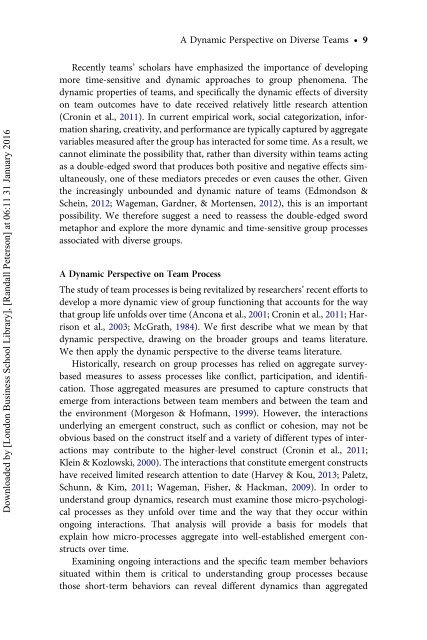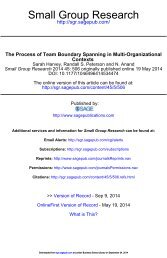A Dynamic Perspective on Diverse Teams: Moving From The Dual Process Model to A Dynamic Coordination-Based Model of Diverse Team Performance - Kannan Srikanth, Sarah Harvey & Randall Peterson
The existing literature on diverse teams suggests that diversity is both helpful to teams in making more information available and encouraging creativity and damaging to teams in reducing cohesion and information sharing. Thus the extant literature suggests that diversity within teams is a double-edged sword that leads to both positive and negative effects simultaneously.
The existing literature on diverse teams suggests that diversity is both helpful to teams in making more information available and encouraging creativity and
damaging to teams in reducing cohesion and information sharing. Thus the
extant literature suggests that diversity within teams is a double-edged sword
that leads to both positive and negative effects simultaneously.
You also want an ePaper? Increase the reach of your titles
YUMPU automatically turns print PDFs into web optimized ePapers that Google loves.
A <str<strong>on</strong>g>Dynamic</str<strong>on</strong>g> <str<strong>on</strong>g>Perspective</str<strong>on</strong>g> <strong>on</strong> <strong>Diverse</strong> <strong><strong>Team</strong>s</strong> † 9<br />
Downloaded by [L<strong>on</strong>d<strong>on</strong> Business School Library], [<strong>Randall</strong> Peters<strong>on</strong>] at 06:11 31 January 2016<br />
Recently teams’ scholars have emphasized the importance <strong>of</strong> developing<br />
more time-sensitive and dynamic approaches <strong>to</strong> group phenomena. <strong>The</strong><br />
dynamic properties <strong>of</strong> teams, and specifically the dynamic effects <strong>of</strong> diversity<br />
<strong>on</strong> team outcomes have <strong>to</strong> date received relatively little research attenti<strong>on</strong><br />
(Cr<strong>on</strong>in et al., 2011). In current empirical work, social categorizati<strong>on</strong>, informati<strong>on</strong><br />
sharing, creativity, and performance are typically captured by aggregate<br />
variables measured after the group has interacted for some time. As a result, we<br />
cannot eliminate the possibility that, rather than diversity within teams acting<br />
as a double-edged sword that produces both positive and negative effects simultaneously,<br />
<strong>on</strong>e <strong>of</strong> these media<strong>to</strong>rs precedes or even causes the other. Given<br />
the increasingly unbounded and dynamic nature <strong>of</strong> teams (Edm<strong>on</strong>ds<strong>on</strong> &<br />
Schein, 2012; Wageman, Gardner, & Mortensen, 2012), this is an important<br />
possibility. We therefore suggest a need <strong>to</strong> reassess the double-edged sword<br />
metaphor and explore the more dynamic and time-sensitive group processes<br />
associated with diverse groups.<br />
A <str<strong>on</strong>g>Dynamic</str<strong>on</strong>g> <str<strong>on</strong>g>Perspective</str<strong>on</strong>g> <strong>on</strong> <strong>Team</strong> <strong>Process</strong><br />
<strong>The</strong> study <strong>of</strong> team processes is being revitalized by researchers’ recent efforts <strong>to</strong><br />
develop a more dynamic view <strong>of</strong> group functi<strong>on</strong>ing that accounts for the way<br />
that group life unfolds over time (Anc<strong>on</strong>a et al., 2001; Cr<strong>on</strong>in et al., 2011; Harris<strong>on</strong><br />
et al., 2003; McGrath, 1984). We first describe what we mean by that<br />
dynamic perspective, drawing <strong>on</strong> the broader groups and teams literature.<br />
We then apply the dynamic perspective <strong>to</strong> the diverse teams literature.<br />
His<strong>to</strong>rically, research <strong>on</strong> group processes has relied <strong>on</strong> aggregate surveybased<br />
measures <strong>to</strong> assess processes like c<strong>on</strong>flict, participati<strong>on</strong>, and identificati<strong>on</strong>.<br />
Those aggregated measures are presumed <strong>to</strong> capture c<strong>on</strong>structs that<br />
emerge from interacti<strong>on</strong>s between team members and between the team and<br />
the envir<strong>on</strong>ment (Morges<strong>on</strong> & H<strong>of</strong>mann, 1999). However, the interacti<strong>on</strong>s<br />
underlying an emergent c<strong>on</strong>struct, such as c<strong>on</strong>flict or cohesi<strong>on</strong>, may not be<br />
obvious based <strong>on</strong> the c<strong>on</strong>struct itself and a variety <strong>of</strong> different types <strong>of</strong> interacti<strong>on</strong>s<br />
may c<strong>on</strong>tribute <strong>to</strong> the higher-level c<strong>on</strong>struct (Cr<strong>on</strong>in et al., 2011;<br />
Klein & Kozlowski, 2000). <strong>The</strong> interacti<strong>on</strong>s that c<strong>on</strong>stitute emergent c<strong>on</strong>structs<br />
have received limited research attenti<strong>on</strong> <strong>to</strong> date (<strong>Harvey</strong> & Kou, 2013; Paletz,<br />
Schunn, & Kim, 2011; Wageman, Fisher, & Hackman, 2009). In order <strong>to</strong><br />
understand group dynamics, research must examine those micro-psychological<br />
processes as they unfold over time and the way that they occur within<br />
<strong>on</strong>going interacti<strong>on</strong>s. That analysis will provide a basis for models that<br />
explain how micro-processes aggregate in<strong>to</strong> well-established emergent c<strong>on</strong>structs<br />
over time.<br />
Examining <strong>on</strong>going interacti<strong>on</strong>s and the specific team member behaviors<br />
situated within them is critical <strong>to</strong> understanding group processes because<br />
those short-term behaviors can reveal different dynamics than aggregated
















